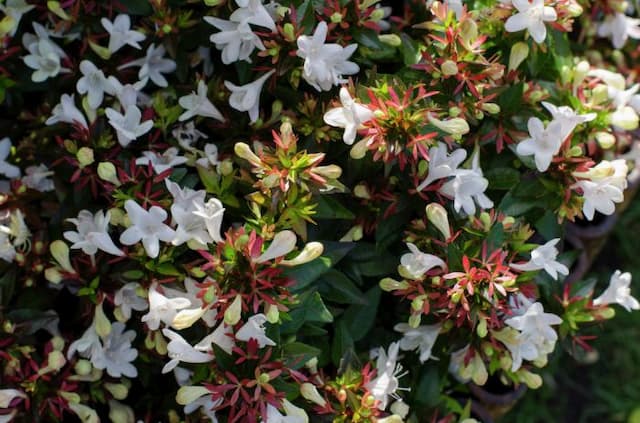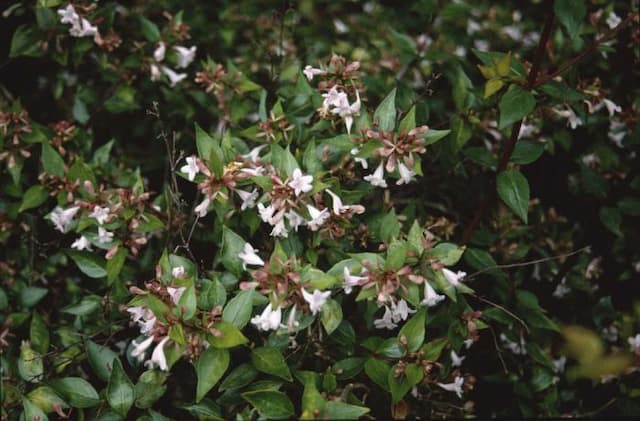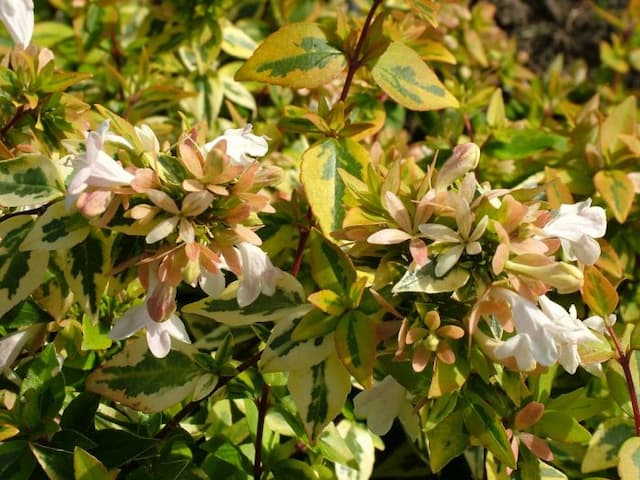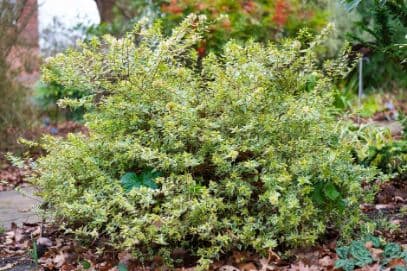Beauty Bush Kolkwitzia amabilis

ABOUT
The plant, commonly known as Beauty Bush, is a deciduous shrub that is recognized for its elegant and graceful appearance. In spring, the Beauty Bush becomes highly ornamental when it is covered in an abundance of small, bell-shaped flowers that exhibit a pale pink hue with a deeper pink throat. These flowers cluster together to form lavish bouquets that drape attractively along the arching branches. The leaves of the Beauty Bush are ovate to lance-shaped, exhibiting a medium to dark green color that provides a backdrop for the floral display. As the seasons change, the foliage may turn to yellow or other warm tones before falling off in autumn, which adds an extra layer of seasonal interest to this plant. Once the flowering has ceased, the Beauty Bush can produce small brownish fruit, which can persist into the fall or even winter, providing a contrast against the bare branches after leaf drop. The overall structure of this shrub includes multiple stems emerging from the base, which then branch out to form a rounded and fountain-like shape, giving it an open, yet somewhat dense appearance. The bark on older stems can acquire a shredded texture over time, which can be particularly noticeable in the winter and adds to the visual interest of the Beauty Bush. With seasonal changes, the Beauty Bush provides a continually evolving spectacle, transitioning from a floral wonder in the spring to an elegant framework of arching branches in the winter. Its charming appearance is appreciated by gardeners who seek plants that offer aesthetic appeal throughout the year.
About this plant
 Names
NamesFamily
Caprifoliaceae.
Synonyms
Beauty Bush, Beautybush, Linnaea Amabilis.
Common names
Linnaea amabilis, Kolkwitzia amabilis var. calicina.
 Toxicity
ToxicityTo humans
Kolkwitzia amabilis, commonly known as Beauty Bush, is not known for its toxicity to humans. There have been no widespread reports of poisoning from ingesting any part of the Beauty Bush. However, as with any plant material, individual allergic reactions or sensitivities are possible. If you suspect poisoning from any plant, it's critical to seek medical attention.
To pets
Beauty Bush, the common name for Kolkwitzia amabilis, does not have a reputation for being toxic to pets. There is limited information on its effects when ingested by animals such as dogs and cats, and it is generally not listed among plants that are toxic to pets. That said, it's always wise to monitor pets and prevent them from eating plant material, as it could potentially cause gastrointestinal upset or an allergic reaction in sensitive individuals. If you notice any sign of illness following ingestion, consult your veterinarian.
 Characteristics
CharacteristicsLife cycle
Perennials
Foliage type
Deciduous
Color of leaves
Green
Flower color
Pink
Height
6-10 feet (1.8-3 meters)
Spread
6-10 feet (1.8-3 meters)
Plant type
Shrub
Hardiness zones
5
Native area
China
Benefits
 General Benefits
General Benefits- Aesthetic Appeal: Kolkwitzia amabilis, commonly known as Beauty Bush, has abundant pink flowers that offer ornamental value to gardens and landscapes.
- Wildlife Attraction: Its blossoms can attract pollinators like bees and butterflies, promoting biodiversity.
- Low Maintenance: Beauty Bush is known for being relatively easy to care for, requiring minimal pruning and can tolerate a range of soil conditions.
- Erosion Control: This shrub can help in controlling erosion when planted on slopes or in areas susceptible to soil loss.
- Privacy Screen: With its dense growth habit, Beauty Bush can be used to create natural privacy screens or living fences.
- Seasonal Interest: Besides the spring flowers, Beauty Bush may show bright fall foliage, adding seasonal interest to the garden.
- Adaptability: It is generally hardy in a variety of climatic conditions, making it suitable for many temperate gardens.
 Medical Properties
Medical PropertiesThis plant is not used for medical purposes.
 Air-purifying Qualities
Air-purifying QualitiesThis plant is not specifically known for air purifying qualities.
 Other Uses
Other Uses- Kolkwitzia amabilis, commonly known as Beautybush, can be used in floral arrangements. The arching branches and abundant small flowers add a natural and elegant touch to bouquets and centerpieces.
- Its dense foliage and rapid growth habit make Beautybush suitable for use as a privacy screen or hedge in landscaping.
- Beautybush's attractive, peeling bark provides winter interest in the garden when the leaves have fallen, offering textural contrast.
- This shrub can be planted on slopes or banks for erosion control, as its root system helps to stabilize the soil.
- The plant can serve as a backdrop for other garden plants, with its height and spread creating an excellent green canvas for showcasing flowers in front of it.
- Beautybush's flowers are attractive to pollinators such as bees and butterflies, enhancing biodiversity in a garden setting.
- Birds are drawn to the shrub for shelter and to its fruit for food, making it a valuable addition to wildlife gardens.
- The plant can be used as a windbreak in areas with strong winds, protecting smaller, more delicate plants in its leeward shade.
- Beautybush wood can be used in small woodworking projects or as material for walking sticks due to its sturdy branches.
- During the autumn, Beautybush can add a splash of color to the landscape with its foliage turning varying shades of yellow to reddish-purple before falling.
Interesting Facts
 Feng Shui
Feng ShuiThe Beauty Bush is not used in Feng Shui practice.
 Zodiac Sign Compitability
Zodiac Sign CompitabilityThe Beauty Bush is not used in astrology practice.
 Plant Symbolism
Plant Symbolism- Charming Beauty: As suggested by its common name "Beauty Bush," Kolkwitzia amabilis symbolizes charm and beauty, reflecting its delightful appearance when in full bloom.
- Renewal: With its capacity to bloom brightly each year, the Beauty Bush encapsulates the idea of rebirth and renewal.
- Loveliness: The delicate pink flowers of the Beauty Bush are often associated with loveliness and grace.
- Grace in Aging: Beauty Bush maintains its pleasing looks even as it matures, symbolizing the gracefulness one can carry throughout the aging process.
- Nature's Splendor: This plant can also represent the splendor of the natural world and the joy it brings to those who take the time to appreciate it.
 Water
WaterThe Beauty Bush, or Kolkwitzia amabilis, prefers consistent moisture, but it is relatively drought tolerant once established. When the plant is newly planted, water it deeply once a week, providing approximately 1-2 gallons depending on the size of the plant and weather conditions. As it matures, water it less frequently, allowing the soil to dry out slightly between waterings. During prolonged dry spells or extreme heat, increase watering to every week. Always avoid overhead watering to prevent leaf diseases, and aim to water at the base of the plant.
 Light
LightBeauty Bush thrives best in full sun to part shade. The ideal spot is one where it can receive at least 6 hours of direct sunlight each day, although it can also perform well in light, dappled shade. Avoid deep shade, as this can impede its flowering and can lead to leggy growth.
 Temperature
TemperatureBeauty Bush is a resilient plant that can tolerate a wide range of temperatures, typically from a minimum of -20°F to a maximum of 100°F. The ideal growing temperatures for Kolkwitzia amabilis hover between 60°F and 85°F, providing a comfortable range for vigorous growth and blooming.
 Pruning
PruningPruning the Beauty Bush is essential to maintain its shape and encourage flowering. Prune immediately after it finishes blooming, typically in late spring or early summer, removing any dead or old wood and shaping as desired. Pruning too late in the season can remove developing buds and reduce the next year's blooms.
 Cleaning
CleaningAs needed
 Soil
SoilBeauty Bush prefers well-draining soil enriched with organic matter and a pH between 6.0 and 7.0 for optimal growth.
 Repotting
RepottingBeauty Bush is a large shrub and is not typically repotted; it's planted outdoors where it has room to grow.
 Humidity & Misting
Humidity & MistingBeauty Bush tolerates average outdoor humidity levels without needing specific humidity adjustments.
 Suitable locations
Suitable locationsIndoor
Ensure bright light and well-draining soil for Beauty Bush.
Outdoor
Plant in sunny spot with well-draining soil; prune after flowering.
Hardiness zone
5-9 USDA.
 Life cycle
Life cycleFor the plant commonly known as Beauty Bush (Kolkwitzia amabilis), the life cycle begins with seed germination, typically occurring in spring when soil temperatures are suitable for growth. Following germination, the seedling emerges and develops into a young plant, which consists of a juvenile phase marked by rapid vegetative growth where the plant establishes its root system and foliage. The Beauty Bush then enters into a mature phase, characterized by the development of the plant's structure and branching, eventually leading to the flowering stage. Flowering typically occurs in late spring to early summer, with the plant producing pink, bell-shaped flowers that attract pollinators. After pollination, fruits, in the form of dry capsules containing seeds, develop and mature; these seeds are then dispersed, either by wind or by animals, to propagate the next generation of plants. Throughout its lifetime, which can be several decades, Beauty Bush requires minimal maintenance, making it a hardy addition to gardens and landscapes.
 Propogation
PropogationPropogation time
Spring-Early Summer
The most popular method of propagating the Beauty Bush, Kolkwitzia amabilis, is done by softwood cuttings. This technique is typically carried out in late spring to early summer, when new growth is green and flexible but not yet hardened. You should select healthy, non-flowering shoots and cut segments that are about 6 inches (approximately 15 centimeters) long, making sure each segment has several leaves. The bottom cut should be just below a leaf node, where the concentration of growth hormones is high. Dipping the cut end into rooting hormone can enhance rooting success. The cuttings should then be planted in a well-draining soil mixture, ensuring the leaf nodes are buried as that's where roots will develop. The environment should be kept humid, which can be achieved by covering the cuttings with a plastic bag or placing them in a propagator to maintain moisture.









